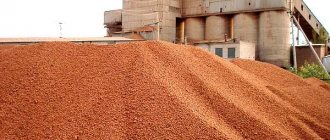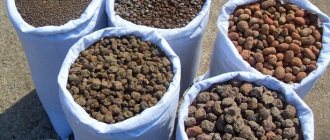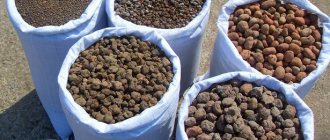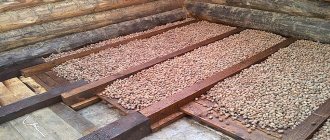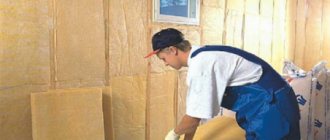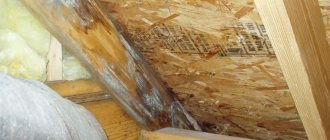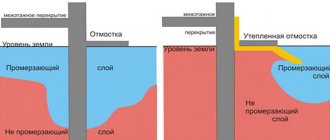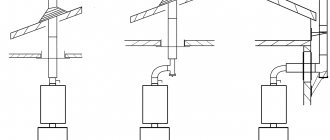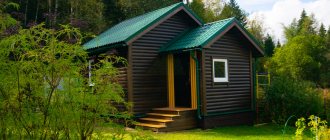Types of expanded clay for insulation
Expanded clay, used as a building material for insulation, has many advantages. According to physical parameters, the material is porous and quite light; it does not create large load effects on the plane. Outwardly, it looks like granules with rounded shapes. The main raw material for production is clay, fired at high temperatures.
This building material is divided into several types.
Expanded clay sand
A finely granulated material used as a filler to reduce the weight of concrete structures. They can be used to insulate the ceiling, spreading it in a layer of up to five centimeters.
Expanded clay sand
Expanded clay gravel
The size of the granules varies from 5 to 40 mm. It is used for the manufacture of structures from lightweight concrete mortars. This type of insulation is used for ceilings, walls and floors of bathhouses.
Floor insulation with expanded clay
On the territory of Russia there is no such housing, bathhouse or other domestic building that would not need to be insulated, since in most of the territory of our country the temperature in winter drops much below the zero mark of the thermometer. Perhaps the most important object where thermal insulation is used indoors is the floor. A warm, cold-resistant floor is the key to the health of the residents of the house, and it’s simply pleasant to walk on a warm floor rather than on ice tiles.
Using expanded clay you can significantly reduce heat loss in your home through the floor.
Advantages and disadvantages of expanded clay insulation
The main advantages of this material are:
- high thermal conductivity;
- light weight;
- long operational period reaching fifty years. In this indicator, expanded clay exceeds many insulation materials;
- increased resistance to aggressive chemical environments;
- environmental cleanliness;
- acceptable cost determined by manufacturing costs;
- the material is not biodegradable during operation, does not emit harmful chemicals, and does not reduce thermal properties;
- expanded clay does not attract rodents;
- the ceiling insulated with expanded clay guarantees high fire-resistant quality of the ceiling;
- The insulating material has a high level of frost resistance and is capable of withstanding at least twenty-five freeze-thaw cycles without reducing its thermal insulation qualities.
A clear disadvantage is the difficulty in achieving complete sound insulation. To solve this problem, you have to pour expanded clay in a layer of up to half a meter.
In addition, expanded clay needs additional means to help retain moisture, in the form of vapor and waterproofing. And if the rooms are very damp, it is not possible to insulate them with expanded clay.
Do-it-yourself thermal insulation of a bathhouse ceiling with expanded clay
In order to make the ceiling surface warmer, it will not be enough to simply fill in the required layer of material. This process is characterized by a number of features that will need to be taken into account in order to obtain the desired result.
Do not forget that thermal insulation of the floor using expanded clay will create an additional load on the main structure of the building. To avoid problems, you will have to provide solid fastenings to the ceiling boards, and, if necessary, reinforce them.
Stage 1. Ensuring protection of the load-bearing surface from moisture.
For these purposes, it is recommended to use the following types of building materials of various types:
- roofing felt - produced in the form of rolls;
- membrane or film;
- mastic - applied by coating the surface.
Features of thermal insulation of a bath
Let's look at the main nuances of insulating a bathhouse.
The steam room needs special thermal insulation, since it is in it that the difference in temperature with the environment can reach a hundred degrees or more. It follows from this that the thermal insulation layer must be made of high-quality materials and have the required thickness.
The main points of installing thermal insulation in a steam room are:
- significant difference in temperatures;
- increased level of humidity in the steam room.
Humidity in a steam room can reach maximum levels, and if appropriate measures are not taken, the walls will constantly be wet, which will entail a reduction in the operating period.
Due to the fact that the main goal is to maintain a high temperature, it is necessary to exclude all options for cold air masses getting inside and heat escaping. There are several ways to solve such problems:
- walls and ceilings are insulated;
- eliminates the possibility of heat leakage through the floors;
- The entrance door is finished with insulating material.
To solve the last problem, there are several options:
- the easiest and most inexpensive - precise fit of the door leaf and frame;
- the device of a high threshold (not lower than fifteen centimeters), which will make it difficult for cold air to penetrate into the room;
- dressing room device.
Ceiling insulation with expanded clay: pros and cons
The positive aspects stand out:
- Environmentally friendly, for use in residential premises;
- Availability of material, can be purchased in any region with delivery;
- Cheapness of the product;
- Low thermal conductivity coefficient, effective insulation;
- Non-flammable material;
- Absorbs noise;
- Shrinkage of the floor when exposed to high loads leads to cracking of the granules, compaction and increased thermal conductivity;
- The thickness of the backfill layer significantly reduces the height of the room;
- High labor costs when performing wet expanded clay concrete screed.
Nevertheless, this material is still used today. The production of expanded clay concrete slabs and blocks is in demand in low-rise construction. Lightweight floor slabs reduce the load on load-bearing walls, which can now be made from lightweight aerated concrete. Insulation of floors using expanded clay is a multidisciplinary stage of work.
Bathhouse insulation technology with expanded clay
The porous structural structure of expanded clay significantly improves its thermal insulation properties. In order to conserve heat indoors as much as possible, you should choose the right not only insulation material, but also insulators.
Ceiling
When deciding on the amount of expanded clay to insulate the bathhouse ceiling, it is necessary to take into account that the minimum layer thickness should be twenty centimeters. The floors of the steam room and other rooms from the attic are insulated. If possible, expanded clay in the form of gravel and sand is used, which gives the backfill layer maximum density.
Insulation of a bathhouse ceiling with expanded clay
All work is carried out in a certain sequence:
- a vapor barrier membrane is laid, the edges overlap by fifteen centimeters. If aluminum foil is chosen for this, then the reflective surface is directed indoors;
- The joining areas are carefully taped with metallized tape. When using roofing felt material, the joints are coated with bitumen mastic;
- the rafters and chimney are vapor barriered above the level of the intended backfill layer. The material is fixed with a construction stapler or masking tape;
- a ten-centimeter layer is made from crushed clay and compacted to improve thermal insulation;
- expanded clay is poured in and leveled;
- the surface of the layer is filled with a screed of sand and cement material.
If the attic is planned for use, then boards can be laid along the beams.
It is not recommended to use expanded clay for ceiling insulation if there is no attic space on site. The fact is that this material can absorb moisture, which negatively affects its thermal insulation abilities. In addition, moisture will make the material heavier, increasing the load on the bathhouse ceiling.
Floor
Insulation of the bathhouse floor with expanded clay is carried out at the stage of construction or repair work. When calculating the layer thickness, it is important to take into account the permissible load forces.
The algorithm of actions is as follows:
- Bituminous waterproofing is spread on the surface of the concrete screed, the edges overlap by ten centimeters. In this case, overhangs of fifteen centimeters are provided on the walls;
- along the entire perimeter of the floor, beacons are fixed in alabaster, determining the thickness of the layer and its evenness;
- if expanded clay is backfilled between logs made of wood material, they are pre-treated with antiseptic agents;
- Expanded clay material is poured fifteen to twenty centimeters thick. It is recommended to use a mixture consisting of different fractions of material;
- the backfill is impregnated with “cement laitance” so that the granules “adhere” to each other;
- on the second day, a reinforcing metal mesh is laid on top so that the structure receives additional strength and rigidity;
- a three-centimeter cement-sand screed is poured and time is given until it dries completely. The end of this process is determined using a glass jar. It is applied with its neck to the floor, if the glass does not fog up, you can move on to the rest of the work;
- a waterproofing layer is attached;
- finishing floor is installed. This type of flooring gains full strength in about one month.
Insulating the floor of a bathhouse with expanded clay
If you decide to insulate the floor with expanded clay on the ground, you will have to create a layer whose thickness is about thirty-five centimeters, which will significantly raise its level. This feature should be taken into account in the process of drawing up project documentation.
Thermal insulation can be done with expanded clay concrete, but this method will not give much effect for the steam room.
The second option for floor insulation is pouring expanded clay into the frame. First of all, a solid base is prepared, then a layer of waterproofing material is laid. After this, the frame is assembled from boards and bars. If the floor area is large, then it is recommended to divide the frame base into several sections, each of which is isolated separately and secured to create a universal structure. Expanded clay is poured in the same way as in the first method. The frame base is hammered with a board on top, and the finishing coating is arranged. A good solution would be to install a membrane base under the boards.
How to insulate the ceiling in a bathhouse with expanded clay
The ceiling in the bathhouse should hold heat well. You can avoid heat loss from the attic by insulating it with expanded clay. It has been used as insulation for a long time, but has not lost its popularity.
Expanded clay is a bulk building material made from clay by firing in special rotary kilns.
It is used not only as insulation, but also as a filler in the manufacture of lightweight concrete.
Thermal insulation qualities are due to its porous structure, which creates the effect of a thermos. Expanded clay is produced in different fractions: from sand (1.5–5 mm) to crushed stone 40 mm. The most popular granule size is 10–20 mm. This is what is most often used when insulating the ceiling.
Expanded clay has a number of positive properties:
- Resistant to cold. Withstands up to 25 cycles of freezing and complete defrosting.
- Not flammable.
- Biologically inactive.
- Easy to use.
- Light weight (1 m³ = 250 kg).
- Low thermal conductivity – 0.12–0.15 W/m².
- Low cost.
At the same time, it also has negative qualities:
Carrying out work
Insulating the ceiling does not mean just pouring a layer of expanded clay. There are a number of nuances in this task that must be taken into account to obtain the desired result.
It should be remembered that insulation with expanded clay makes the structure heavier. Therefore, you will need to take care of the reliable fastening of the ceiling boards and, if necessary, strengthen them.
Before starting work, you need to prepare moisture and vapor barrier materials. The following options are valid:
Insulating a bathhouse begins with laying moisture-proofing materials. The simplest option is to apply clay coating to the ceiling boards. The thickness of such a vapor barrier should be 1.5–2 cm. The use of this insulation requires great physical effort and time. The coating takes at least 3 weeks to dry. Therefore, crumpled clay is used for the same purposes. Waterproofing is laid on the coating layer, the role of which is polyethylene film or roofing felt. The width of the material should be 10–15 cm greater than the distance between the floor beams. If the moisture barrier is laid overlapping, then the seams are glued with bitumen mastic or tape.
Expanded clay is poured between the beams, directly onto the prepared insulating material. Heat-saving properties are fully ensured when the insulation thickness is more than 10 cm. The recommended value is 14–16 cm. Expanded clay is poured into an even layer and leveled. For compaction purposes, material fractions of different sizes are used. Special attention is paid to the completeness of the backfill around the rafters, chimney and walls. The quality of laying the material directly affects heat loss. To prevent convection currents from occurring in the expanded clay layer, it is recommended to fill the insulating material with ordinary dry sand on top, having previously covered the expanded clay layer with agrofibre. It prevents sand from spilling out and does not create a “greenhouse effect.” Layer thickness – 3–5 cm.
Work on insulating the ceiling of a wooden house is almost no different from the technology described above. There is no need to install a vapor barrier here. Only waterproofing is used. If the house is two-story, then lighter materials are used for the ceiling of the first floor or it is not insulated at all.
Checking completed work
After this, you need to ensure the quality of the insulation made. To do this, the bathhouse is heated and all sources of cold air (doors, ventilation, etc.) are closed. After warming up the room, the temperature is measured and the time is recorded. If it decreases quickly, then the insulation work was performed poorly. Then the reasons for the temperature drop are identified and eliminated. After this, the check is repeated. In a good sauna, the heat lasts up to 4 hours.
Periodically it is necessary to inspect the attic space for damage to the roof covering and moisture leaks. Such inspections are also necessary during heavy precipitation.
The ingress of water into the expanded clay layer significantly reduces its heat-saving qualities. Therefore, all leaks must be eliminated.
Insulating the ceiling alone will not solve the problems of maintaining heat in the room. Expanded clay is an almost ideal heat insulator, but only the integrated use of energy-saving technologies and materials will make your creation a truly Russian bathhouse.
Insulating the ceiling with expanded clay is one way to avoid heat leaks from the attic.
What are the ways to insulate a bath ceiling?
The ceiling of the bathhouse is built only from wood. The method of insulating the ceiling depends on how it is constructed.
A hemmed ceiling is installed by hemming boards located from the inside of the bathhouse to the beams. On the attic side, two layers of vapor barrier are laid, as well as insulation. In this case, roofing felt is used as an insulator. Two layers of insulation must be used to ensure that they cope perfectly with the insulation entering the attic.
Installation of lining in a bathhouse - see here
Foil is often used in bathhouse ceiling insulation technology. Not only does it keep steam out of the attic, but it also keeps condensation out.
A flat ceiling is used regardless of whether there are beams. In this case, the canvas boards are installed on the top of the walls or on the trim. To insulate such a floor, mineral wool slabs are used. It is not recommended to install thermal insulation from polystyrene foam boards.
If you plan to insulate a floor-type ceiling, then you need to take a particularly close look at those areas that are directly adjacent to the pipe. Here you need to strengthen the ceiling and secure it with fireproof bricks.
When making a panel ceiling, boards of pre-prepared length are used. Frames are then assembled from these boards. Such panels are then insulated with asbestos cement sheets.
Insulation of a bathhouse ceiling using expanded clay
Expanded clay as a ceiling insulation is often used to insulate baths. The advantages of expanded clay are obvious:
- Expanded clay does not decompose, unlike other materials.
- Over time, expanded clay does not emit toxic gases.
- Rodents cannot live in expanded clay.
- Expanded clay has a high degree of fire safety - it is fire-resistant and does not burn.
- It has a high degree of sound insulation.
- It is very waterproof, which allows you to pay less attention to the waterproofing of ceilings.
- A significant advantage of expanded clay these days is its low price.
- Expanded clay also withstands many cycles of freezing and defrosting, which makes it possible to use it in areas with cold climates or weather that changes frequently and sharply in winter.
Also see - Methods for insulating a frame bath
If you are thinking about how to insulate the roof of a bathhouse with your own hands, here is another proof of the usefulness of expanded clay: a layer of material only ten to fifteen centimeters thick, significant (almost seventy percent).
When purchasing expanded clay, you need to consider its shrinkage. This will help to purchase material in the right quantities and carry out construction work competently.
Is it possible to pour expanded clay under the floor of a bathhouse?
Up to 15% of the building’s heat escapes through the ceiling, especially if there is an attic and roof above the rooms. To avoid significant heat loss, the ceilings of a house or bathhouse are insulated. For these purposes, mineral wool, foam plastic and other materials are used, but most often builders give preference to expanded clay.
It is best to carry out thermal insulation of the ceiling at the stage of building a house or bathhouse, since re-covering, installing insulation and new ceilings can take a lot of time and money. Insulating the ceiling with expanded clay will not only maintain a comfortable temperature in a private house or bathhouse and increase sound insulation, but will also prevent the formation of condensation and, as a result, the appearance of fungus and mold on the walls.
Insulating a bathhouse using expanded clay: advantages of materials and nuances when laying it
The bathhouse is a structure that is present on many people’s property.
Although it is not used for living, nevertheless, this building also needs insulation. If this work is not carried out, the quality of steam procedures will be low, since the heated rooms of the bathhouse will quickly cool down. In addition, it will take the owner of the facility a lot of time to heat a bathhouse without insulation. Today there are many materials that can effectively insulate a bath. Many people make their choice in favor of modern thermal insulators. Along with mineral wool, more inexpensive solutions are available today that are no less effective in preserving heat in rooms. When the owner of a bathhouse needs to insulate the surfaces in this building, he can use not only mineral wool, but also inexpensive expanded clay.
It is suitable not only for thermal insulation of a bathhouse, but also in cases where it is necessary to create comfortable conditions for living in the attic. In terms of its characteristics, expanded clay has a lot in common with mineral wool, which is popular on the market. They have the same advantages. In particular, expanded clay is an environmentally friendly material. This quality is due to the fact that in the manufacture of this heat insulator, ordinary clay is used as the main raw material.
This insulation is resistant to high temperatures. The disadvantage of expanded clay is the same as that of mineral wool. It easily absorbs moisture. Being moistened, it loses its properties. Anyone who decides to use this material for thermal insulation of their bath should know about this. In order for the insulation to be high-quality, durable and reliable, it is necessary to provide protection against moisture for the expanded clay. When using material to insulate the ceiling from below, it is necessary to protect it from steam penetration. At the top, the insulation layer also needs a protective layer. It must prevent contact of the material with atmospheric moisture and condensation.
You should know that the granules of this insulation have higher thermal conductivity compared to mineral wool. Therefore, in order to create effective insulation, it is necessary to create a fairly thick layer of this material in terms of thickness. The expanded clay layer must have a thickness of at least 30 cm. Only in this case can you count on high-quality thermal insulation of the ceiling in the bathhouse. This material is an excellent solution for steam rooms in the bathhouse, which are large in size. In spacious rooms, floor beams have a very impressive vertical section. As a result, there are natural niches of great depth. They are excellent for filling in this natural insulation in sufficient quantity for high-quality insulation.
Subscribe to the Construction and Repair channel. Give a royal like if it was interesting :)
Source
What is the difficulty of insulating the floor in a bathhouse?
Very often, a bathhouse is a separate house in the country. It’s rare for anyone to maintain above-zero temperatures in winter. More often it is “heated” only for use and this is the difficulty. For insulation, you need a material that can withstand frost/defrost and is not afraid of moisture. After all, if we are talking about a Russian bath, and not a sauna, then the humidity in the steam room will be close to 90%.
Typically, a bathhouse and a change house often appear on the site first. And only then does the construction of the house begin
Another option to choose from is security. Baths are usually heated by wood stoves, and in most cases the buildings themselves are made of wood. The combination of open fire and wood is always dangerous. Therefore, it is advisable to insulate with non-flammable material. But there are no such things, and therefore they try to choose one that has a high ignition temperature, does not smoke when burning, and does not spread combustion.
How and with what to insulate the floor in a bathhouse. Choosing the best options
There are also requirements for floor construction. We don’t heat a bathhouse every day, even if it is in the yard, and therefore the design must be thought out so that during “downtime” the materials are dried. To do this, you need a working and well-thought-out ventilation system, a blown/ventilated subfloor. Otherwise, literally in a couple of years everything will have to be redone.
Floor installation in the attic
In the case where the attic space is planned to be used as a habitable space or for household needs, then the work on insulating the ceiling in the house with expanded clay must be completed with a screed. In this case, it is not necessary to lay the top layer of vapor barrier. But before spreading the cement-sand mortar over the surface of the insulation, it is necessary to saturate the very top layer of expanded clay with cement laitance. This will make the solution easier to install.
If the screed serves as an independent coating, then after it has been leveled and dried, the work is considered complete. However, to equip an attic room using a dry screed, we install a finished floor. For this, you can use any materials: engineered wood, laminate, thick plywood or ceramic tiles.
- Exterior finishing
Foam insulation
The insulation of a steam room in a bathhouse in the floor area is quite often also carried out with polystyrene foam, which is made from polystyrene foam granules. The material is sold in the form of sheets, the thickness of which reaches 150 mm. The sheets can be used for floor insulation. Among the advantages it is necessary to highlight:
- low cost;
- low specific gravity;
- low heat transfer coefficient;
- lack of ability to pass water and absorb moisture.
However, polystyrene foam does not allow water vapor and air to pass through, burns and melts, during which it emits suffocating smoke, and can also be used at temperatures no higher than 70˚.
What will you need?
The warmth of a room largely depends on the type of floor. Expanded clay is undoubtedly an effective insulation material. It is worth considering that the material consists of granules of different sizes, and accordingly, the thermal conductivity also differs.
In order for the floor to be well insulated, it is better to purchase a mixture of several types of expanded clay: sand and gravel (the granules should be 5-20 mm in size). This mass is sold under the universal brand M300.
For work, it is advisable to take a large volume of expanded clay, since the granules may break as a result of transportation. Before backfilling, beacons are installed (to level the screed), so care should be taken to ensure that they are present. You will also need cement mortar, cement, and reinforcing mesh (for the stability of the structure).
Please note: in order for the granules to stick together better, they must be of different sizes. It is important to ensure that there are no unevenness when filling the material, otherwise all the work will be in vain. For stability, a metal mesh is installed after the work - it is worth purchasing it in advance.

